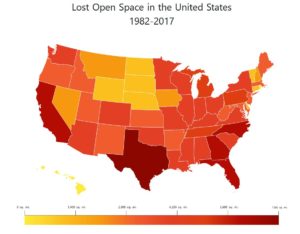May 3, 2022
Open Space is Necessary for a Sustainable Future
 Are revolving construction projects in your community making you ask yourself questions like, “How much space is gone?” and, “How much open space is left?”
Are revolving construction projects in your community making you ask yourself questions like, “How much space is gone?” and, “How much open space is left?”
Open Space is a term used for undeveloped land. More specifically, the EPA describes open space as “any open piece of land that is undeveloped (has no buildings or other built structures) and is accessible to the public.”
There are maps online to learn more about the loss of open space over time in the U.S. Supported by two decades of studies, these interactive maps, hosted by NUMBERSUSA, visually illustrate the demise of open space nationwide. The purpose of this collection is to examine the powerful counterforce of urban sprawl in the United States.
There are two factors that contribute to this country’s loss of open spaces due to urban sprawl:
Population growth (67%)
Growth of developed land per resident resulting from all other factors (33%)
Also shared on the website’s Executive Summary page, is this call to action to Congress: “Today’s urgent national efforts, such as the 30×30 movement, are based on changing the trajectory of open-space loss by 2030 without changing the trajectory of population growth. Echoing the conclusions of the Clinton task force, our latest national sprawl study finds that formula is highly unlikely to be successful. The outlook for open-space conservation could be much more positive however, if Congress simply would follow the Clinton task force recommendation to adopt annual immigration numerical caps consistent with the goal of stabilizing the country’s population size.”

 Are revolving construction projects in your community making you ask yourself questions like, “How much space is gone?” and, “How much open space is left?”
Are revolving construction projects in your community making you ask yourself questions like, “How much space is gone?” and, “How much open space is left?”

Paula Sullivan
I share this concern. I have a hard time believing that the last census was correct regarding California. California lost a seat in the House because of lower population (first time in 171 years). Logic and my eyes tell me this cannot be true. Homeless population up and down the San Joaquin valley has sky-rocketed, and new homes and whole neighborhoods shooting up like never before. Please help me understand this. Thank you, Paula
Laurence
Urban sprawl, fueled by mass immigration, is destroying millions of acres of farmland and forest. The only way to stop this destruction is to reduce immigration, but the government/corporate Axis will not do so.
Nelson Hyde Chick
And of course, this problem can’t be fixed while we gain another fifty million by mid-century.